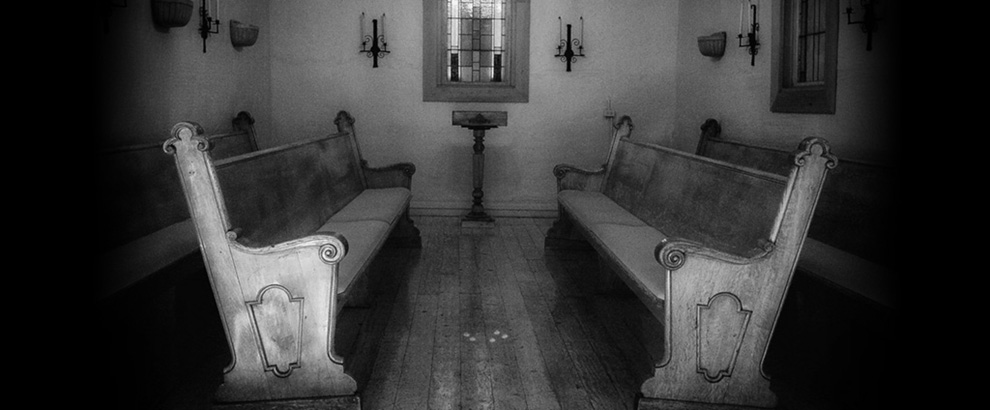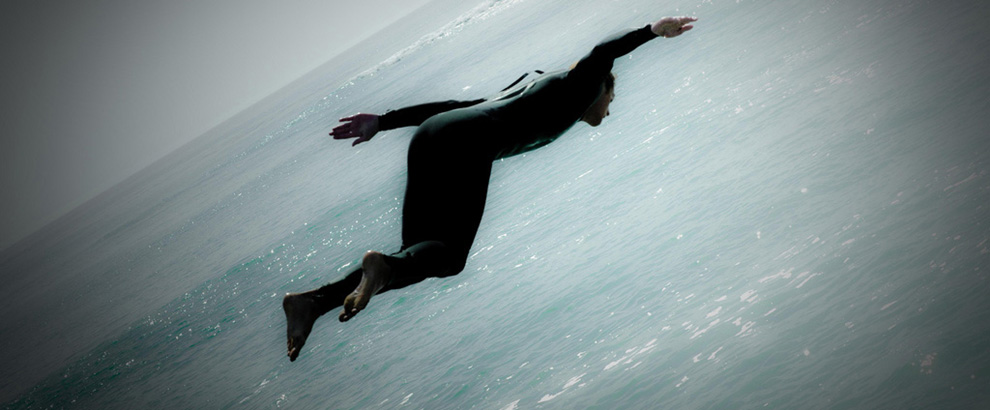
At root, we go to art, whatever its form, to be changed. To alter our perception, to see something new or something we have seen before in a new way, to contemplate the mysterious, the beautiful, the joyous, the awful, the searing.
The best art upends our world, shatters our assumptions, pierces our ignorance and venality. It inspires question upon question, wonder upon wonderment, and as it does so, it assaults us physically—roiling our stomachs, fluttering our hearts, goosebumping our necks, disturbing our sleep.
All art aspires to these things if it is to be worthy of its name.
In this post, I want to discuss three related works of art that in my estimation accomplish all—or at least a good deal—of the above.
1. Tightrope walker Philippe Petit’s unparalleled 138-foot traverse between the World Trade Center’s Twin Towers in New York City in 1974.
2. Director James Marsh’s gripping 2008 film, “Man on Wire,” which chronicled Petit’s feat and won the following year’s Academy Award for Best Documentary.
3. Colum McCann’s 2009 novel, “Let the Great World Spin,” which uses Petit’s walk as the central, recurring metaphor for a profound meditation on grief, loss, sacrifice, redemption, and beauty.
What you may notice about these three items is that the latter two are more or less traditional “art” works involving film and writing, while the first is an event, a feat, a piece of physical performance art with roots in the circus. If you were taking one of those intelligence tests involving the question, “Which of these three items don’t belong with the other two?”, you might separate Petit’s actual feat from the later art works that were inspired by it.
All of it adds up to a soaring artistic vision mixed with other-worldly physical prowess, a playful mischievous spirit, a steel trap engineering mind, and the organizational skills of a small army of earnest event planners.
Fair enough. But in truth, Petit’s aerial act 1,350 feet above the ungiving concrete of lower Manhattan transcended anything we might think of as physically-based performance. Sure, we can marvel at Steph Curry’s wizardry with a basketball and justifiably enough refer to it as “art.”
But Petit’s walk was fundamentally different than anything Curry or Tom Brady or even Rudolf Nureyev ever dared on their respective stages, not least because he put his very life on the line with every step.
However much we marvel at the remarkable physical skills of those “artists” mentioned above, we have to heap extra credit on Petit’s sheer audacity in dreaming up his aerial act, and the nearly breathtaking due diligence he had to bring to planning and accomplishing its every last detail. This included not only the daunting physical challenges he would face out on his wire, but also the countless logistical requirements of hauling up and then setting into place nearly a ton of cable and other equipment that would be required on the top floors of the towers.
All of it adds up to a soaring artistic vision mixed with other-worldly physical prowess, a playful mischievous spirit, a steel trap engineering mind, and the organizational skills of a small army of earnest event planners.

“I started, as a young, self-taught wirewalker, to dream of not so much conquering the universe, but, as a poet, conquering beautiful stages.”
***
Petit and his aides took more than 200 “reconnaissance” missions to the World Trade Center in order to scope out every last variable of his venture. Every trip required utmost secrecy from all involved parties, along with zero cooperation from the officials at his chosen venue.
Though Marsh’s documentary deftly chronicles the invaluable logistical support Petit received from various aides and co-conspirators who were fully on board with the project’s epic scale, he is revealed not only as the central actor and athlete, but also the master planner, producer, director, choreographer and capermeister of what surely stands as one of the most fantastic and improbable performances in human history.
Petit himself doubted it could be done upon his first view of the towers after arriving in New York:
“The minute I got out of the subway, climbing the steps, looking at them, I knew that they were no dream. I knew that my dream was destroyed instantly… Impossible, impossible, impossible. It’s clearly impossible, not only to walk across, this I probably hardly thought of it. But to bring almost like a ton of equipment, secretly, to rig a wire for hours, to guideline it. It’s clearly out of human scale, but something in me pulls me toward touching it.”
And another, more prosaic factor seen by one of Petit’s assistants in the Marsh documentary:
“It was like a bank robbery, and that pleased him enormously,”
No, Petit did not submit an application for a “permit” to walk between the towers. First, the effort would have been rejected out of hand as absurd and dangerous, and second, making it “legal” would in any case have reduced some portion of the drama it engendered for Petit as a clandestine act of rebellion, defying all convention and even the most fertile imagination.
Perhaps a novelist as talented as McCann could have conjured such an event, but since Petit did the honors himself, McCann was left to begin his own tale with the specter of Petit’s actual walk above the city, from where McCann would weave his own phantasm of lives in the balance on their own thin wires of fate. (More on McCann’s story below.)
Marsh’s movie is a fast-moving and dramatic pastiche of narrative, on-camera commentary by the still handsome and relentlessly verbose Petit, interviews of his accomplices nearly 35 years later, home movie footage of his practice regimen from the time, some simulated footage of event preparations, and the relative paucity of actual film and still shots there are from the day.
Petit appears throughout as a kind of highly charismatic, mischievous prankster with a mystical underlay, playful to the hilt while still rapturous that he had been able to bring a few moments of transcendent beauty and wonder to an all-too-often sleepwalking world.
“Look up!” he implicitly exhorted that world on what was likely the peak day of his life at 24 years of age. (Though other crossings such as the Sydney Harbour Bridge pylons, the towers of Notre Dame Cathedral in Paris and the airspace outside David Letterman’s studios in New York added more than a few additional dollops of excitement to his career.)
Petit’s Twin Towers feat was as if a grove of gigantic redwood or sequoia trees got plunked down furtively overnight in the middle of SkyscraperLand, all but invisible at first to the hordes of ants going busily about their day. Then one of those ants happens to look up for one reason or other and says, “Hey! What is THAT?”
Not really being an ant but a heretofore somnabulent human, that person nudges someone else and repeats louder: “HEY! What IS that?”
And so it spreads, one nudge to the next, until literally thousands of New Yorkers stop what they are doing all over the city, either watching transfixed and pointing from whatever angle they can view the spectacle or else following news reports as the story makes its way through the pre-social media communication wires.
The sight they behold includes Petit running and turning on the wire, going backwards, lying down on his back, and smiling broadly at many junctures. Basically cavorting like a child with a very glad heart on a snow day home from school, all while waving off waiting cops and holding a 55-pound balance bar that somehow managed not to wear him out through the entire 43-minute escapade.
When reporters ask the inevitable “Why?” question after Petit finally steps to “safety” right into the shackles held by police officers, he responds:
“There is no ‘why.’ I did something magical and mysterious…There was peace and immensity and in the middle of all this madness, I suddenly had hope and joy.”
That is exactly what this chronicle of his exploits did for me in an otherwise cold winter of not inconsiderable discontent with the state of our world.
***

“…to refuse to repeat yourself, to see every day, every year, every idea as a true challenge, and then you are going to live your life on a tightrope.”
***
“At his center he never moved. He thought of his stomach as a bowl of water. If he got it wrong, the bowl would right itself. He felt for the curve of the cable with the arch and then sole of his foot. A second step and a third. He went out beyond the first guy lines, all of him in synch. Within seconds he was pureness moving, and he could do anything he liked. He was inside and outside his body at the same time, indulging in what it meant to belong to the air…”
That’s Colum McCann, crawling body and soul into Philippe Petit as the tightrope walker launches out into the leaden August skies above New York City. “Let the Great World Spin” won the National Book Award for fiction in 2009, and its opening five pages serve as a prelude that sets the stage not so much for Petit’s walk as it does for the incredulous, gape-mouthed, rumor-mongering, pointing, breathless crowds whom Petit virtually hypnotized that day despite being a mere speck in the sky more than a quarter-mile above them.
New York, home to so much and so at home with itself that its t-shirts bellow out, “New York Fucking City”—and everyone knows exactly what that means.
 And in that city, down at the ground level of the everyday world, live a thousand, a thousand upon thousand tales of derring-do and despair, grace and degradation, desperation and triumph, grief and moral compromise. “What’s he doing up there?” the ground dwellers ask, though the far more urgent question for them is often, “What am I doing in here?”
And in that city, down at the ground level of the everyday world, live a thousand, a thousand upon thousand tales of derring-do and despair, grace and degradation, desperation and triumph, grief and moral compromise. “What’s he doing up there?” the ground dwellers ask, though the far more urgent question for them is often, “What am I doing in here?”
What McCann’s characters are doing is trying to save the world one prostitute at a time (a monkish, absurdly idealistic young man who offers hookers a few minutes of safe haven and washing facilities in between their trysts).
Or trying to process deep wells of grief (a group of economically and culturally disparate mothers brought together by the one commonality of losing sons in Vietnam).
Or dreaming of renown (a graffiti tagger-turned-photographer chronicling the ever more outlandish and risky venues the best taggers explore).
And by pursuing various other dreams, be they of fame or forgiveness, riches or absolution, that too often, with too much dispiriting repetition, lead to more want and suffering instead.
All of these characters intersect though don’t necessarily interact in the novel, sharing only some slice, some view, some few hushed words or finger-pointings aimed at the strange endeavor (“He’s doing what?”) taking place that day high in the sky.

Their lives take on remarkable and raw resonance in the hands of a master storyteller like McCann, a native of Ireland who has lived long enough in the U.S. (since 1986) to combine that experience with a writer’s natural penchant for absorbing the atmosphere of every space he or she enters, be it a bar, an art exhibit, a country, or another person’s heart.
“Let the Great World Spin” has the added emotional undertow of chronicling an event and a time and—most pointedly and poignantly—a landmark that existed when the novel was set but was no more when it was written and published.
The Towers’ demise on 9/11 adds an extra dimension of pathos to the tale, those buildings made so noble and alive by Petit’s feat (feet!) now just a memory, one suffused with awfulness and tragedy at that.
Yet McCann offers a measure of healing at novel’s end, hard-earned and heavy with pain as the greatest healing always is. Whatever the nature of that pain and however deep it goes, the great world does continue to spin, sometimes offering up heaping mounds of amazement and wonder, other times the simpler but no less important spectacle of everyday people navigating their own tightropes, seeking the connection, comfort and grace of making it safely to the other side while they continue to dare hoping, against often formidable odds, that a friendly and welcoming face there awaits.
***
Marvelous footage of the youthful antics of Petit here, accompanied by the perfectly matched musical score of a band as brash as he is…
http://www.facebook.com/andrew.hidas/
Twitter: @AndrewHidas
Deep appreciation to the photographers! Unless otherwise stated, some rights reserved under Creative Commons licensing.
Elizabeth Haslam, whose photos (except for the books) grace the rotating banner at the top of this page. See more at: https://www.flickr.com/photos/lizhaslam/
Library books photo by Larry Rose, all rights reserved, contact: larry@rosefoto.com
Small Petit photo at top of page and photo of him lying down by Associated Press, photographer unknown. Photo of Petit looking back by Alan Weiner, Associated Press.
Twin Towers photo by foorttography, see more at: https://www.flickr.com/photos/foortography/















Andrew,
Thank you for this writing that is, as usual, sterling in its quality. I stumbled upon “Man On Wire” a few years ago with no advance knowledge of what it was or who it was about. To say the least, watching it stopped my world, in a good way to be sure. I’ve watched it several times since that first viewing and the audacity, courage, athleticism, and artistry of this extraordinary human feat by Phillipe Petit amazes me even more every time I watch it.
Thanks for reminding me of this feat and inspiring me to experience even more layers of wonderment about it.
Terry
Terry, “stopping my world” indeed—that exactly describes it. Seeing the movie made me feel like I was right there, just as slack-jawed and amazed as those otherwise jaded New Yorkers, who thought they’d seen it all, until now…One of those movies and events that stays with you and has you mulling for weeks afterwards. Think I’ll follow your lead in revisiting it, thanks!
The images of all 3 works of art made a clear impression when I first encountered them several years ago, and have been swirling through my heart and brain again as I read this blog post. Thank you so much for helping it to surface once again in my consciousness. I rejoiced in the audacity of his youth, his purpose and skill, and memories of that mythical simpler time of the 1970s, when such feats and capers could awaken us, inspire us, without harm to anyone. It is no wonder that McCann chose to weave his story of the woes and joys of his decidedly earthbound mortal characters around this moment in time, with its exhortation to look up, to be brave and fearless. Oh, how we need that encouragement.
I, like many humans, am not as overtly courageous or inventive, and certainly not as graceful, as Phillipe Petit. I am so often not even able to give a name to my own particular tightrope or able to identify what I am walking between or toward, yet surely I am: walking, balancing, finding the bravery for little steps, to find the space and confidence to lay right down on that wire and rest in the middle of the journey. Unlike Petit, I am afraid I actually fall, on many occasions, but I do get back on. I do look up.
One aspect of his walk and that novel that has come to my mind as I have mulled over all this again, is the balancing pole that Petit carried onto the wire with him on several of the trips out and back on that August day. It weighed 55 pounds, easily a third of his body weight, and yet he seemingly carried it lightly, skillfully. It looks as heavy and cumbersome as an albatross, and is so long and heavy it seems it would have been an enormous burden, and maybe it was. Yet it seems to have provided both balance and to have created a sort of focus. I would like to ask him about that pole. It has made me assess again the things I carry out onto that wire every day, the issues that are sometimes so heavy and burdensome: memories, insecurities, beliefs, fears, joys. They provide a focus, and carrying them requires great skill. They either provide balance or have trained me to find it; I’m not sure which. And it is a flat out joy to occasionally be able to lay them down, and to rest on the wire for a moment and just gaze at the sky on this skinny, skinny wedge and remember, and for a moment forget, the audacity this whole enterprise requires, and the joy that can be ours.
I love the notion that we all have our tightropes….when we are way out of our league and don’t know what is going to happen next. Yet, we try to prepare as much as we can. For instance, I’m trying to take good care of an elderly parent in decline. That is my tightrope right now — I’m facing “the audacity the whole enterprise requires, and the joy that can be [hers and mine]. ” Cheers, Andrew.